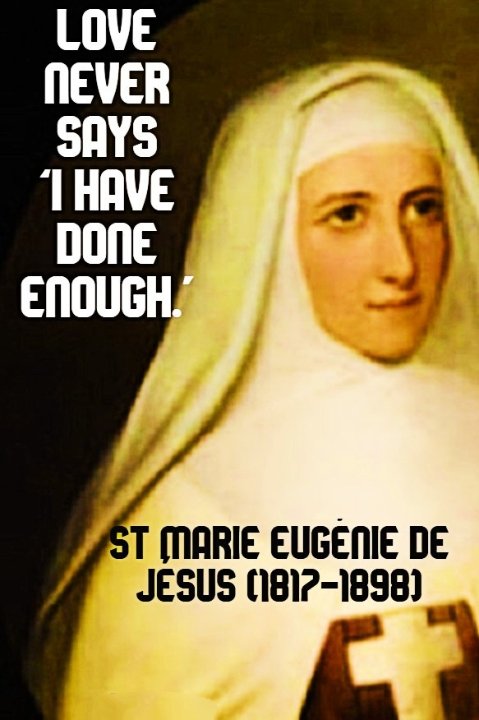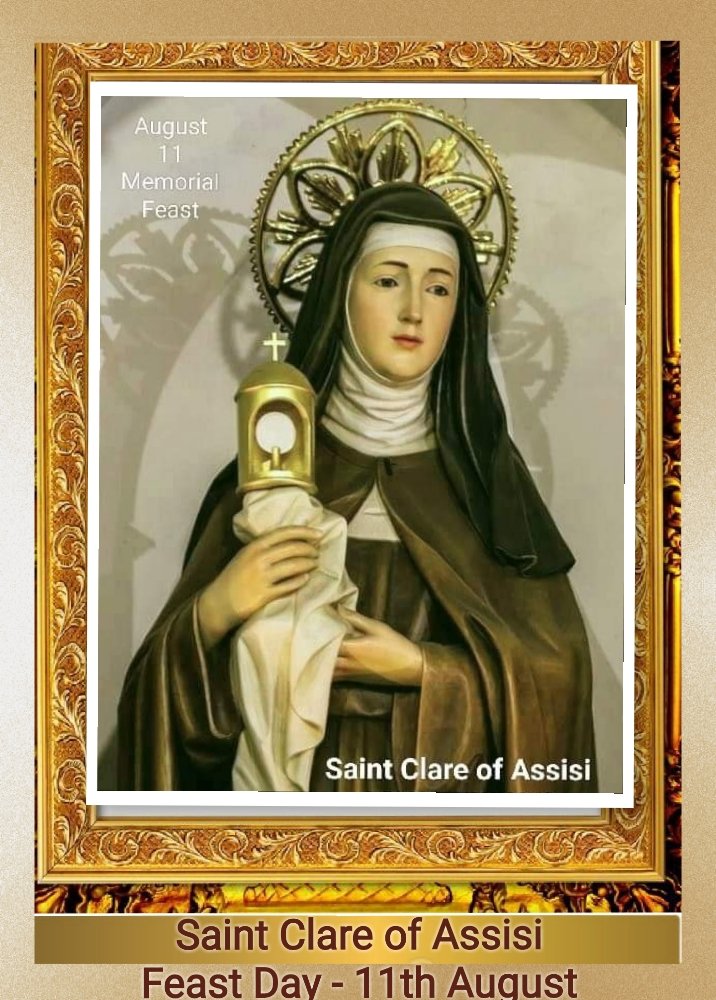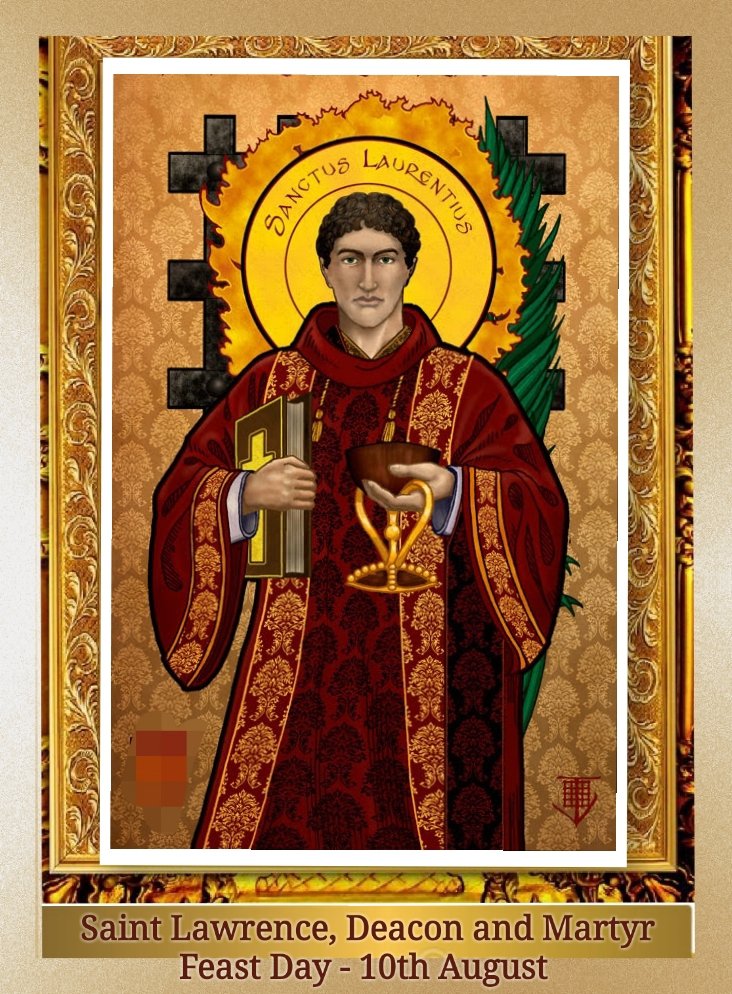FEAST OF SAINT MARIE EUGENIE OF JESUS
FEAST DAY – 10th MARCH
Marie-Eugénie de Jésus (25 August 1817 – 10 March 1898), born Anne-Eugénie Milleret de Brou, was a French Roman Catholic professed religious and the foundress of the Religious of the Assumption. Her life was not geared towards faith in her childhood until the reception of her First Communion which seemed to transform her into a pious and discerning individual.
She likewise experienced a sudden conversion after hearing a sermon that led her to found an order dedicated to the education of the poor. However, her religious life was not without its own set of trials, for complications prevented her order from receiving full pontifical approval due to a select few causing problems as well as the deaths of many followers from tuberculosis in the beginning of the order’s life.
Anne-Eugénie Milleret de Brou was born during the night of 25 August 1817 in Metz as one of five children (three males and two females) to Jacques Milleret and Eleonore-Eugénie de Brou. Her baptism was celebrated on 5 October. Her father was a follower of Voltaire and a liberal which often put him into conflict with his diminishing faith. He made his fortune from banking and politics.

In 1822 her brother Charles (1813–1822) died and her little sister Elizabeth died in 1823. She had two older brothers, Eugene (b. 1802) and Louis (b. 1815–16). She grew up in a chateau in the suburb of Priesch, north of Paris. When she was 13, her parents separated as a result of her father’s financial misfortunes. She moved to Paris with her mother and often accompanied her when visiting poor families in need.
Her mother died of cholera in 1832, after a short period of illness, and she spent the remainder of her teens between two sets of relations. On one side she found her family concerned with material pleasures, while the other demonstrated a narrow spirit of piousness. Separated from the brother who had been her main companion as a child, she wondered about life and how to live out the spirit of faith and justice that her mother had taught her.
In 1825 she made a pilgrimage to the shrine of Sainte-Anne d’Auray where she felt called to found a religious order dedicated to educating the poor. On 25 December 1829, Christmas day, she took her First Communion and it proved to be a life-changing experience for her. Through the reception of this sacrament she experienced the presence of God, a profound spiritual moment proving to be one she remembered the rest of her life.
During Lent in 1836 Milleret de Brou was invited to listen to a series of lectures at the Notre Dame cathedral, which the then-Abbé Lacordaire, a known preacher and social commentator, gave. His preaching lead her to have a profound conversion experience, and she became passionate about the messages from the Gospel and thus a dedicated servant to God. In July 1837, she announced to her father and brother that she wanted to become a religious sister, and was heartbroken that they found this dream incomprehensible.
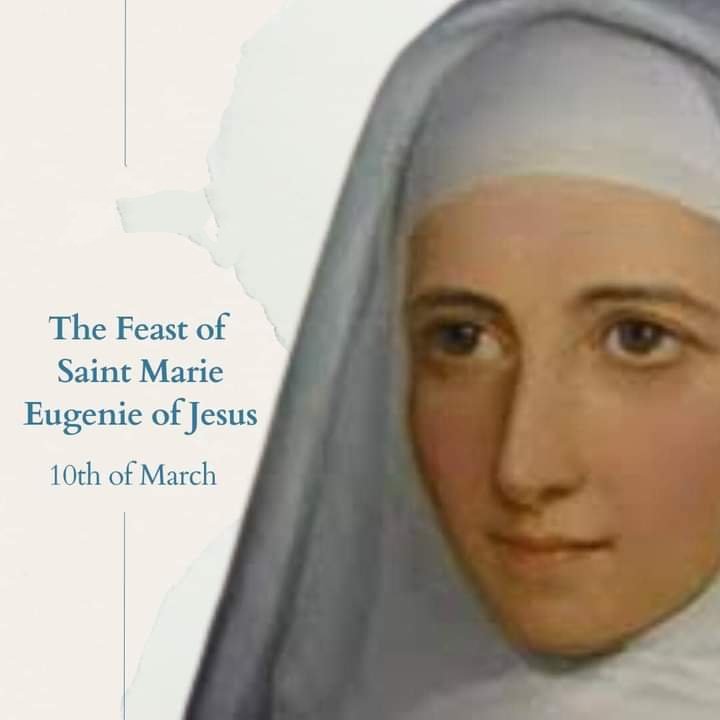
She made a brief novitiate with the Sisters of the Visitation on 15 August 1838 before leaving. She went to confession to the Abbé Théodore Combalot, who told her that he was looking for someone to help him found a religious order devoted to the Blessed Mother and the education of the poor. He believed that she would be such a founder capable of seeing out his vision.
On 30 April 1839 Milleret de Brou founded the Religious of the Assumption with four companions. The congregation began in a small apartment on the Rue Ferou in Paris and celebrated their first Mass together as a religious congregation on 9 November 1839. In March 1841 she was made the Superior of the order and held the position until she resigned due to ill health. On 14 August 1841 she made her initial vows and her perpetual profession on 25 December 1844.
In May 1866 Marie-Eugénie de Jésus set off for Rome and visited the tomb of Saint Peter before setting off to visit the catacombs and other Roman churches, and then attending Mass in the room where Saint Ignatius of Loyola died. On 31 May she had a private audience with Pope Pius IX. Marie-Eugénie de Jésus returned to Rome where on 11 April 1888 Pope Leo XIII issued pontifical approval to her order and signed the decree in her presence.
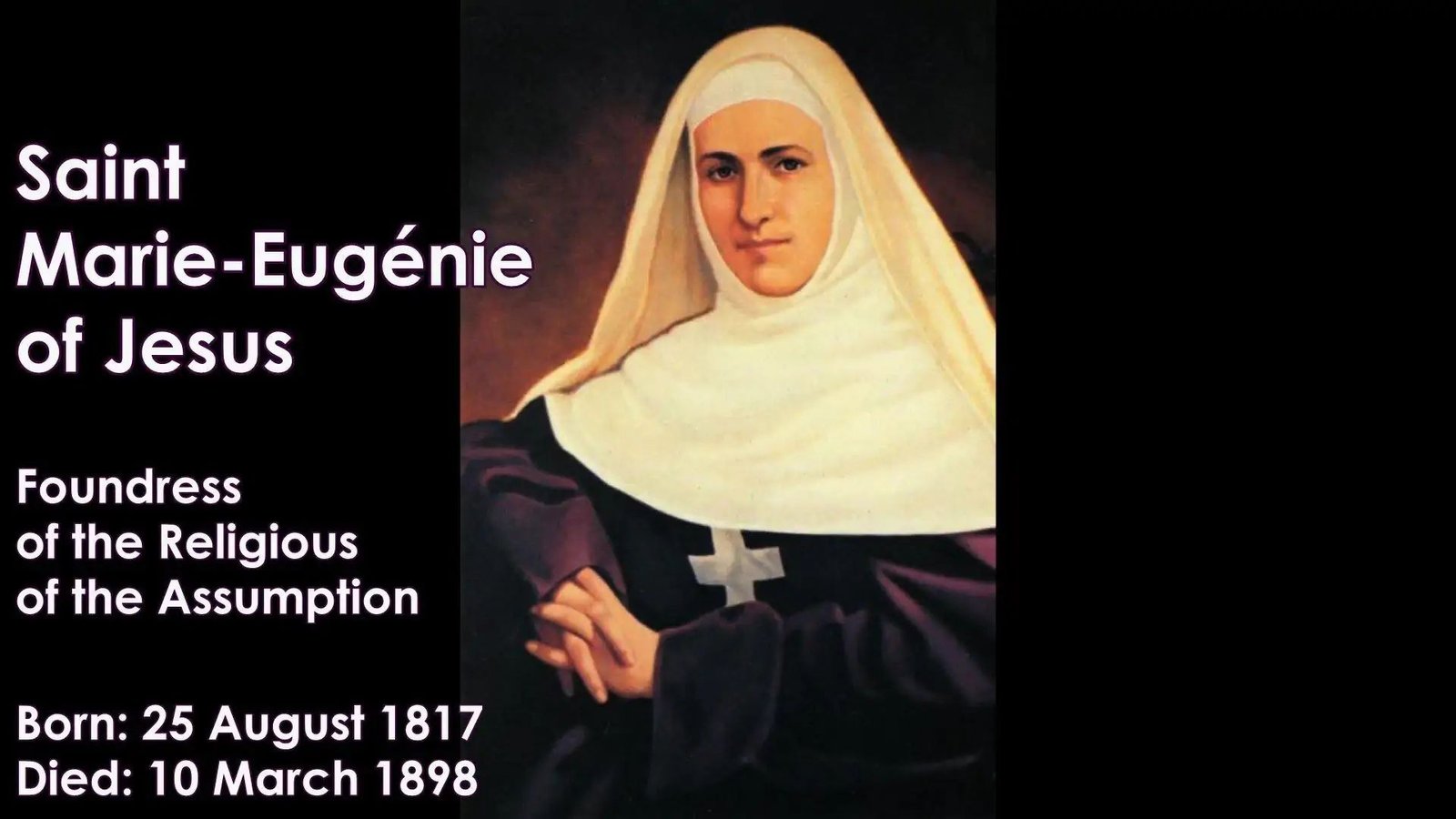
In 1893, Marie-Eugénie de Jésus returned to Rome and met Leo XIII again. In 1894 she attempted to return to Rome but had to stop in Genoa due to falling ill en route. In late 1894 she visited Madrid and San Sebastián. In March 1895 she went with her nurse Sister Marie Michel to Rome and made stops along Montpellier and Nice as well as Cannes and Genoa; she returned to France three months later.
The aging nun suffered a small stroke in October 1897 which caused her speech to slow; her legs began to grow frail and movement became more difficult over time. Marie-Eugénie de Jésus died on 10 March 1898. She received the Viaticum on 9 March and the Last Rites on 13 February when it seemed she would die despite her bouncing back. The Cardinal Archbishop of Reims Benoît-Marie Langénieux celebrated her funeral on 12 March. As of 2019 her order had 1300 followers from 44 different nationalities, in 34 countries on four continents
The sainthood process opened in the Paris archdiocese in an informative process that Cardinal Jean Verdier oversaw from 1934 until its closure in 1936; her writings received theological approval on two separate occasions on 1 February 1939 and on 8 July 1949. The formal introduction to the cause came on 17 April 1940 under Pope Pius XII and she became titled as a Servant of God.
The Congregation for Rites in Rome validated the Sainthood processes on 14 December 1945. An antepreparatory committee approved the cause on 9 May 1951 as did a preparatory one on 7 June 1960 and the general committee on 6 June 1961. On 21 June 1961 she became titled as Venerable after Pope John XXIII confirmed that she had lived a life of heroic virtue. Pope Paul VI beatified her on 9 February 1975 in Saint Peter’s Square.
The miracle for canonization was opened and closed in 2003 in the Manila archdiocese while the Congregation for the Causes of Saints validated the process on 30 April 2004. Medical experts approved this miracle on 27 January 2005 as did the theologians on 14 February 2006 and the C.C.S. members on 12 December 2006. Pope Benedict XVI approved this miracle on 16 December 2006 and formalized the date for the canonization on 23 February 2007 at a consistory; Benedict XVI canonized her on 3 June 2007.
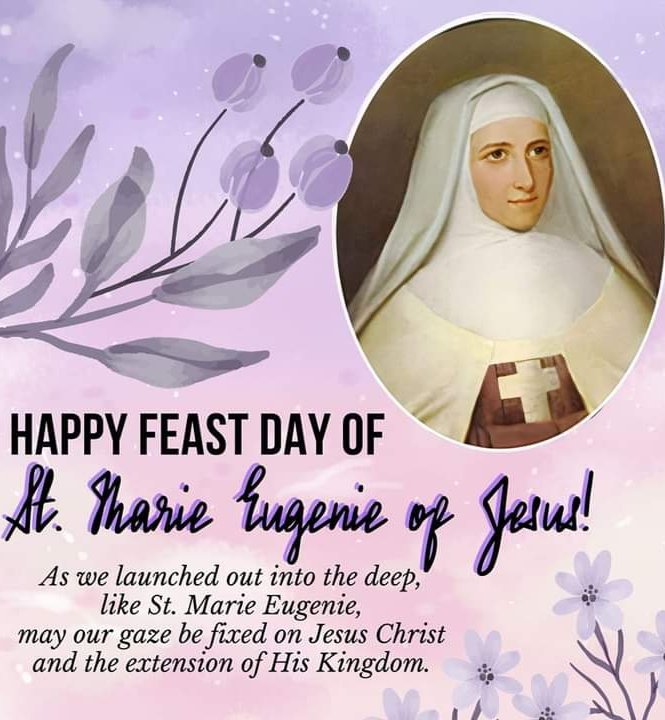
The canonization miracle was the healing of Risa Bondoc (b. February 1995) who had a condition from her birth that prevented the two halves of her brain from joining. Her mother – who did not know of this condition – had put Risa up for adoption and so Ditos and Carmen Bondoc adopted her and had taken her to specialists, to no avail.
PRAYER
O God, who called Marie-Eugénie to seek your Kingdom in this world through the pursuit of perfect charity, grant, we pray, through her intercession that we may advance with joyful spirit along the way of love.
Through our Lord Jesus Christ, your Son, who lives and reigns with you in the unity of the Holy Spirit, one God, for ever and ever. Amen
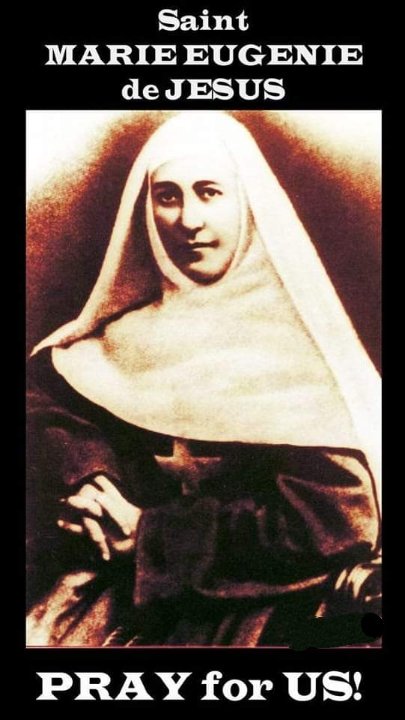 St Marie Eugenie of Jesus, pray for us.
St Marie Eugenie of Jesus, pray for us.
+++++++++++++++++++++++++++++++++++++++++++++++++++++++++++++++++++++
ALSO CELEBRATED:
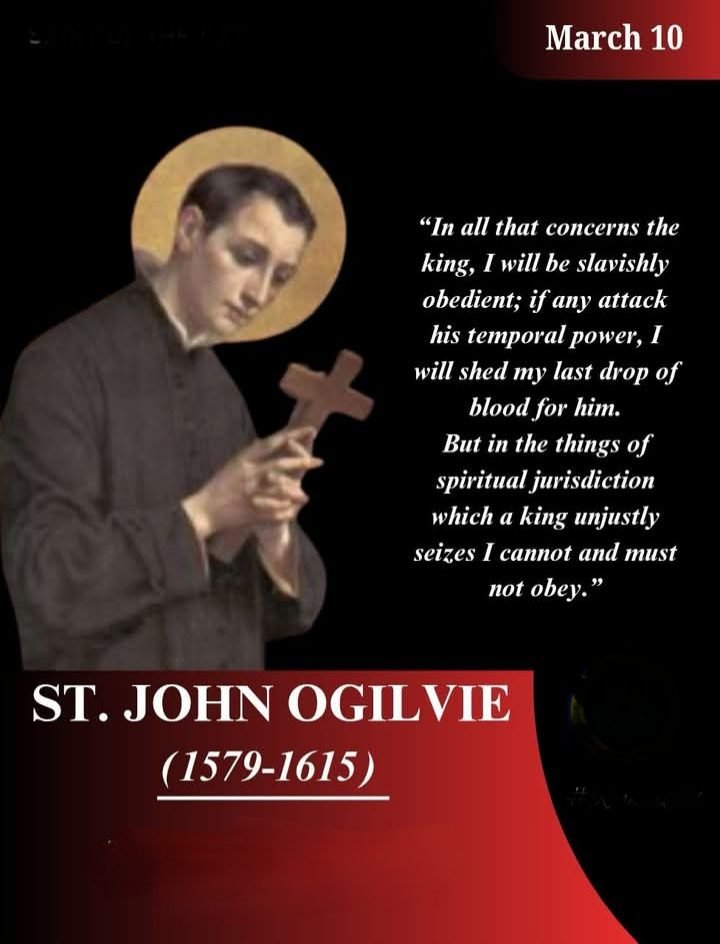
FEAST OF SAINT JOHN OGILVIE – 10 MARCH
Saint John Ogilvie was a 16th- and 17th-century Scottish Jesuit priest who converted from Protestantism to Catholicism and ultimately died as a martyr. Born in 1579 to a noble family with both Catholic and Presbyterian relatives, Ogilvie was raised as a Calvinist but began questioning its teachings, particularly the concept of predestination.
St. John Ogilvie was born into a wealthy, Scottish Calvinist family in 1579. Despite the faith he was raised in, Ogilvie was educated at Catholic schools. He converted to Catholicism at the age of 17 in the midst of religious turmoil. Ogilvie joined the Society of Jesus in 1608 and was ordained a priest two years later. He preached in Normandy and ministered to the few remaining Catholics in Glasgow (at that time, any endorsement of Catholicism was illegal in Scotland). Ogilvie preached in secret and celebrated Mass in private homes.
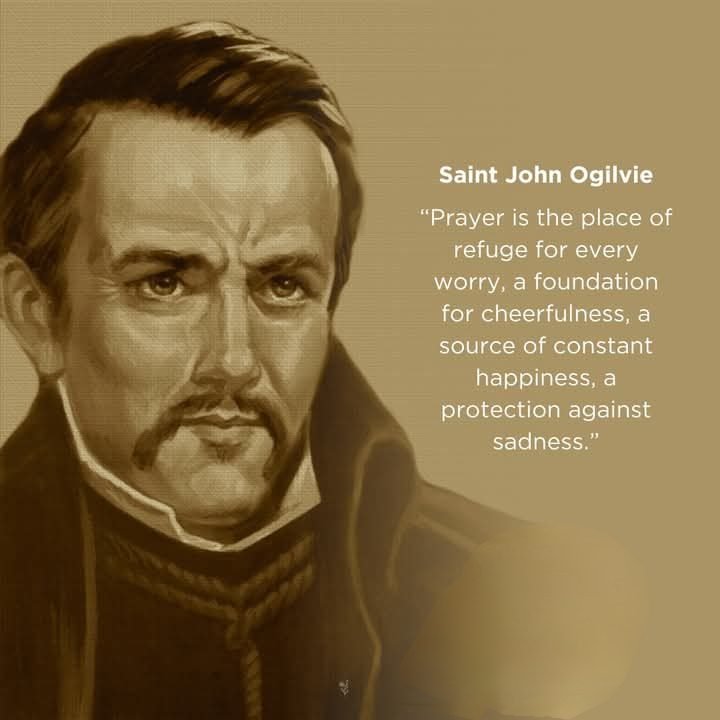
He was betrayed less than a year later, arrested and tortured. Ogilvie was forced to stay awake for eight days and interrogators tried to divulge the names of other Catholics. Ogilvie remained firm and was convicted of high treason. On March 10, 1615, a captive St. John Ogilvie was paraded through the streets of Glasgow, hanged and disembowelled.
At his execution, Ogilvie threw his rosary into the crowd and the recipient converted to Catholicism. His last words were “If there be here any hidden Catholics, let them pray for me but the prayers of heretics I will not have.” St. John Ogilvie was beatified in 1929 and canonized in 1976; he is the only post-Reformation saint from Scotland.
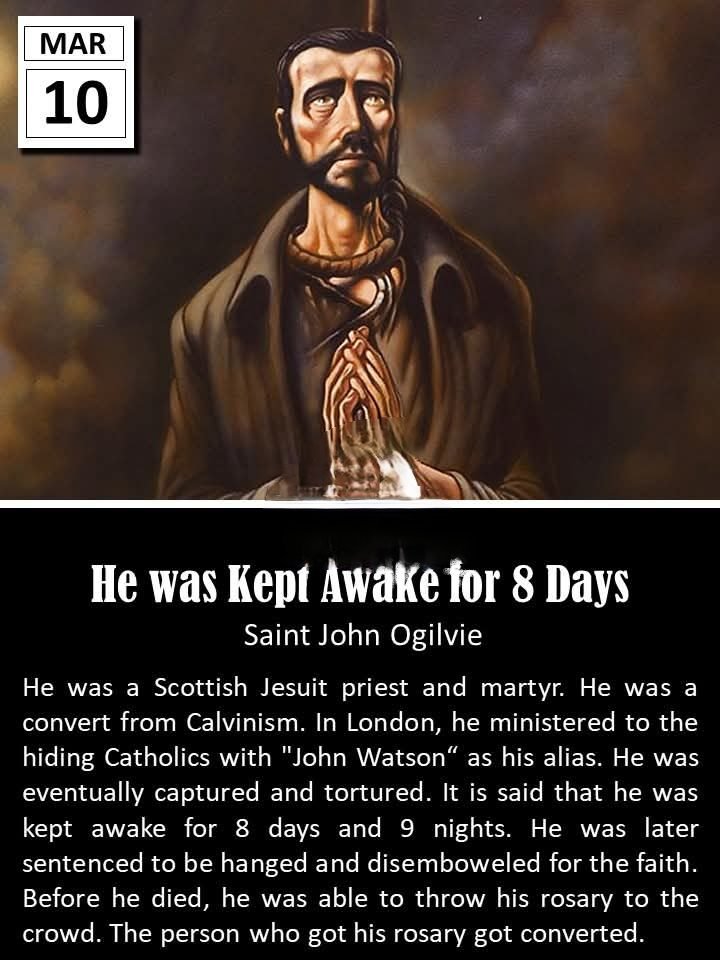
He discovered Catholicism while studying in Belgium and decided to join the Church at the age of 17. Ogilvie became a Jesuit novice in 1599 and was ordained as a priest in Paris in 1610. Despite warnings from fellow Jesuits, Ogilvie felt a strong calling to return to Scotland and encourage its return to Catholicism.
Ogilvie’s missionary work in Scotland was marked by secrecy and danger, as Catholicism was heavily persecuted at the time. He was eventually arrested, imprisoned, and tortured for refusing to acknowledge the king’s supremacy over the Church. Ogilvie’s bravery and dedication to his faith ultimately led to his execution by hanging on March 10, 1615.
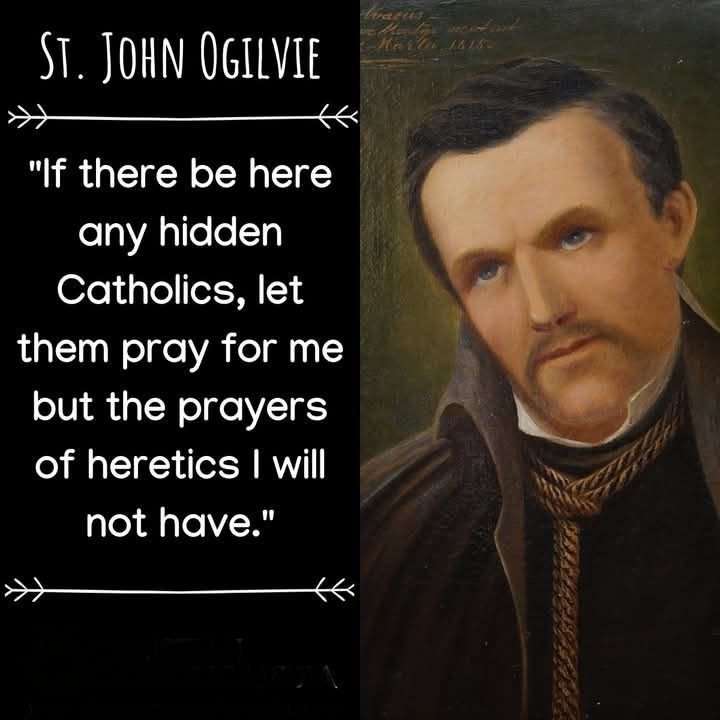
He was canonized as a saint by Pope Paul VI in 1976. He is remembered for his courage, dedication, and commitment to his faith.
PRAYER
God our Father, fountain of all blessing, We thank you for the countless graces that come to us in answer to the prayers of your saints. With great confidence we ask you in the name of your Son and through the prayers of St John Ogilvie to help us in all our needs. We pray in Jesus’ Name. Amen
(Prayer Source: catholicculture.org)
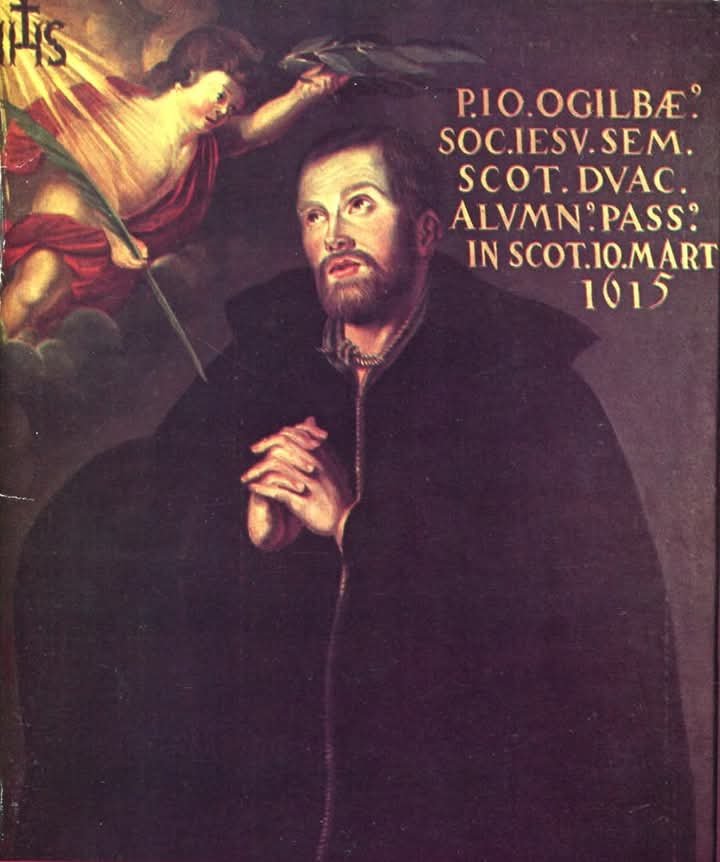
Saint John Ogilvie, you held fast to the faith, even unto martyrdom. With the grace of God, may we have a loving heart in the midst of trials. May we, like you, “be of good cheer” and trust in the love of God, surrendering to His Holy Will. Amen
Saint John Ogilvie, pray for us!
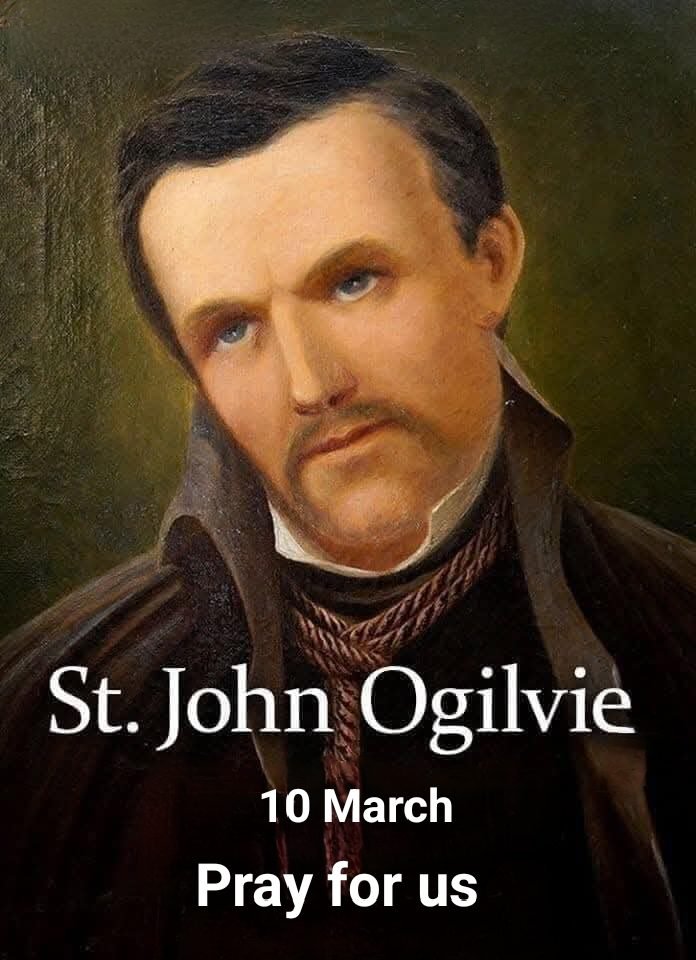
++++++++++++++++++++++++++++++++++++++++++++++++++++++++++++++++++++++
SAINT OF THE DAY – 10 MARCH
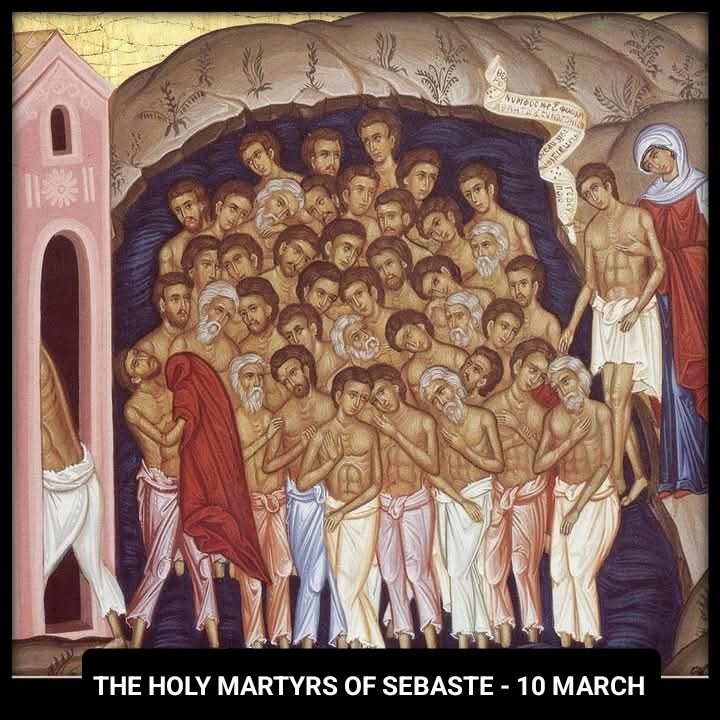
THE 40 HOLY MARTYRS OF SEBASTE
In the year 313, St. Constantine the Great issued an edict granting Christians religious freedom, and officially recognizing Christianity equally with paganism under the law. But his co-ruler Licinius was a pagan, and he decided to stamp out Christianity in his part of the Empire. As Licinius prepared his army to fight Constantine, he decided to remove Christians from his army, fearing mutiny.
One of the military commanders of that time in the Armenian city of Sebaste was Agricola, a zealous champion of idolatry. Under his command was a company of forty Cappadocians, brave soldiers who had distinguished themselves in many battles. When these Christian soldiers refused to offer sacrifice to the pagan gods, Agricola locked them up in prison. The soldiers occupied themselves with prayer and psalmody, and during the night they heard a voice saying, “Persevere until the end, then you shall be saved.”
On the following morning, the soldiers were again taken to Agricola. This time the pagan tried flattery. He began to praise their valor, their youth and strength, and once more he urged them to renounce Christ and thereby win themselves the respect and favor of their emperor.
Seven days later, the renowned judge Licius arrived at Sebaste and put the soldiers on trial. The men steadfastly answered, “Take not only our military insignia, but also our lives, since nothing is more precious to us than Christ God.” Licius then ordered his servants to stone the holy martyrs. But the stones missed them and returned to strike those who had thrown them. One stone thrown by Licius hit Agricola in the face, smashing his teeth. The torturers realized that the soldiers were guarded by some invisible power. In prison, the soldiers spent the night in prayer and again they heard the voice of the Lord comforting them: “He who believes in me, though he die, yet shall he live (John 11:25). Be brave and fear not, for you shall obtain imperishable crowns.”
On the following day the judge repeated the interrogation in front of the torturer, but the soldiers remained unyielding.
It was winter, and there was a severe frost. They lined up the holy soldiers, threw them into a lake near the city, and set a guard to prevent them from coming out of the water. In order to break the will of the martyrs, a warm bath-house was set up on the shore. During the first hour of the night, when the cold had become unbearable, one of the soldiers made a dash for the bath-house, but stepped over the threshold and fell down dead.
During the third hour of the night, the Lord sent consolation to the martyrs. Suddenly there was light, the ice melted away, and the water in the lake became warm. All the guards were asleep, except for Aggias, who was keeping watch. Looking at the lake he saw that a radiant crown had appeared over the head of each martyr. Aglaius counted thirty-nine crowns and realized that the soldier who fled had lost his crown.
Aggias then woke up the other guards, took off his uniform and said to them, “I too am a Christian,” and he joined the martyrs. Standing in the water he prayed, “Lord God, I believe in You, in Whom these soldiers believe. Add me to their number, and make me worthy to suffer with Your servants.” Then a fortieth crown appeared over his head.
In the morning, the torturers saw with surprise that the martyrs were still alive, and their guard Aggias was glorifying Christ together with them. They led the soldiers out of the water and broke their legs. During this horrible execution the mother of the youngest of the soldiers, Meliton, pleaded with her son to persevere until death.
They put the bodies of the martyrs on a cart and committed them to fire. Young Meliton was still breathing, and they left him on the ground. His mother then picked up her son, and on her own shoulders she carried him behind the cart. When Meliton drew his last breath, his mother put him on the cart with the bodies of his fellow sufferers. The bodies of the saints were tossed in the fire, and their charred bones were thrown into the water, so that Christians would not gather them up.
Three days later the martyrs appeared in a dream to Saint Peter, Bishop of Sebaste, and commanded him to bury their remains. The bishop together with several clergy gathered up the relics of the glorious martyrs by night and buried them with honor.
O Holy Martyrs of Sebaste, pray for us!

